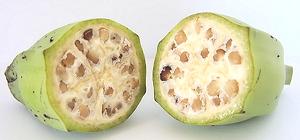 [Gluay, Kluai (Thai)]
[Gluay, Kluai (Thai)]
Bananas are very important in the cuisine of Thailand, and probably more
than 50 varieties are grown there, each with unique characteristics that
make it suitable for particular uses. Those most commonly found in
markets in Thailand are listed below. The leaves are also much used for
food service, for wrapping foods for steaming, and other applications.
Even the stems have uses, but not as food (though they are fed to
animals).
These are shipped to California either dead green or showing just a trace of yellowing. If buying green for cooking, don't buy too far ahead as they ripen fairly quickly. When they are at the right stage you can slow further ripening by refrigerating. They are generally about 5 inches long (not counting the stem) and weight 3.5 ounces.
Subst: The Mexican Burro Banana, available in Hispanic markets, is considered a good substitute.
More on Bananas.
No other Thai Bananas than the Naam Waa are available in markets here in Southern California, but there are a number of them popular in Thailand that may eventually appear here.
 [Musa balbisiana B Group]
[Musa balbisiana B Group]
Wild bananas are not found in the markets, here or in Thailand. They are widespread, but their fruit is full of hard black seeds. These plants form clumps in the wild, but are not planted around homes because of their association with the ghostess Nang Tani. When seen, she takes the form of a young woman with a slightly green complexion, floating with her feet just above the ground. She usually has a gentle disposition, but it's considered unwise to take risks with ghosts. Yellow ribbons are tied around banana plants she is thought to live within.
bn_thaiz 181004 - www.clovegarden.com
©Andrew Grygus - agryg@clovegarden.com - Photos on this
page not otherwise credited are © cg1 -
Linking to and non-commercial use of this page permitted